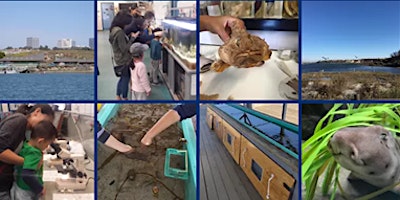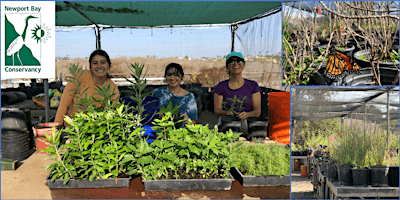
Northern HarrierUpper Newport Bay has an incredible richness and diversity of wildlife that ranges from microscopic plankton floating in its tidal waters to coyotes and bobcats that are seen on the bluffs and elsewhere around the Bay.
Plants

Saltmarsh Bird’s Beak
Upper Newport Bay is blessed with a wide variety of plant species, each adapted to the particular habitat in which it grows.
The plants found in the saltmarsh are called halophytes – from the Greek words for salt (halo) and lover (phyte). In the lower tidal areas cordgrass predominates. This plant is adapted to grow submerged in saltwater for much of the time. On higher ground that is covered by water only occasionally pickleweed is most abundant. Other halophytes found at or above the high tide mark and adjacent roadside/barren areas are the saltmarsh bird’s beak, fleshy jaumea, sea lavender, brewer’s saltbush, sea blite, and alkali heath.
Saltmarsh bird’s beak (Cordylanthus maritimus) is a federal and state endangered species of plant. This annual herb is so named because its flower is like a bird’s beak pointed towards the sky. At UNB it is found mostly in dredge spoil disposal areas. Growth seems to occur in the vicinity of freshwater sources which appear to be necessary for germination.
In the freshwater marsh cattail, bulrush (tule) and sedge are found. These non-halophytes are adapted to live in standing freshwater. The marsh and pond areas are fed by streams and seeps. Trees and bushes that like the moist soil conditions found on and near stream banks include the native willow, cottonwood, sycamore and mulefat, and the invasive, non-native Brazilian pepper. The term riparian is used to describe stream-side habitat.
Two main plant communities are found in the uplands surrounding the Bay. They are grassland and coastal sage scrub. The characteristic native coastal sage scrub plants include California sagebrush and buckwheat. Non-native plants include wild mustards and pampas grass.
Learn about the problem with Invasive Plants.
The following pictorial guides prepared by two of NBC’s long-time Naturalists provide information on virtually all the plants found at Upper Newport Bay.
Don Millar’s Some Common Plants of Upper Newport Bay
Bob De Ruff’s Vascular Plants of Upper Newport Bay
This essay by Naturalist Dick Newell will also provide useful information to help you improve your plant identification skills.
Birds

California least tern
Upper Newport Bay is home to nearly 200 species of birds, including several endangered species. It is one of the top birding sites in the country, attracting birders from the east coast of the USA and beyond. The Sea and Sage Audubon Society conducts a monthly bird count at the Bay in conjunction with the California Department of Fish and Wildlife and Newport Bay Conservancy. For more information and bird count results, visit the Sea and Sage Bird Counts page.
The Bay is an important rest stop and/or winter home for birds migrating from Canada and Alaska, and up to 30,000 birds can be seen here on any one day during the winter months. During the spring and summer many birds that have migrated from the south nest here, together with other birds that are year-round residents. Nesting birds include the endangered Ridgway’s rail and California least tern.
Learn more about migration.
The following endangered bird species are found at UNB:
| Common Name | Scientific Name | Federal Status | State Status |
| Ridgway’s rail | Rallus obsoletus | Endangered | Endangered |
| California least tern | Sterna antillarum browni | Endangered | Endangered |
| Belding’s savannah sparrow | Passerculus sandwichensis beldingi | Not Listed | Endangered |
| Least Bell’s vireo | Vireo bellii pusillus | Endangered | Endangered |
Printable unb-bird-list (pdf)
Learn more about the secretive Ridgway’s rail.
Though not endangered, the osprey is somewhat of a celebrity at UNB. It is believed that the first successful osprey breeding happened again in 2006, over 100 years since it was last recorded. Learn about this historic osprey nesting. Read a 2010 osprey update.
Mammals

Bobcat
The largest mammals found here at Upper Newport Bay are the bobcat, the coyote and the raccoon. The most numerous are the various common species of small rodents.
One female bobcat called Babe has become quite a celebrity. She and/or her offspring are seen regularly on the patio of the Interpretive Center. Bobcats play an important role in our ecosystems, particularly in terms of keeping pest populations under control. While generally not considered a threat to humans; they are powerful animals and, when cornered, can be dangerous. As with all wildlife, never approach or corner a bobcat. Upon encountering one on the trail or other setting, give them a wide berth and a way to exit.
Coyotes are found in all areas of Orange County. They are a native species and a critical component of the ecosystem. While far from domesticated, coyotes show little fear of humans and have become comfortable living in close proximity to our communities. Although they tend to do most of their hunting after dusk, the so-called ‘prairie wolf” can be active at any time. Under normal circumstance, a coyote is not a danger to humans. They are, however, territorial and will respond aggressively if they or their family are threatened. It is also worth noting that it is hard for a coyote to pass up a free meal or, as the case may be, a defenseless pet.
The raccoon, though considered cute by many, is becoming a major problem at Upper Newport Bay. An abundance of food (in some cases offered by humans) and a lack of enemies has led to a thriving population that preys on the eggs and chicks of endangered and threatened birds.
Mammals of Upper Newport Bay (1989 List)
| Virginia opossum | Didelphis virginiana |
| Desert shrew | Notosorex crawfordi |
| Broad-footed mole | Scapanus latimanus |
| Raccoon | Procyon lotor |
| Longtail weasel | Mustela frenata |
| Western spotted skunk | Spilogale gracilis |
| Striped skunk | Mephitis mephitis |
| Coyote | Canus latrans |
| Bobcat | Lynx rufus |
| California ground squirrel | Spermophilus beecheyi |
| Deer mouse | Peromfscus manioulatus |
| Western harvest mouse | Reithrodontomys megalotis. |
| House mouse | Mus musculus |
| California vole | Microtus californicus |
| Norway rat | Rattus norvegicus |
| Botta’s pocket gopher | Thomomys bottae |
| Desert cottontail | Sylvilagus audubonii. |
Amphibians & Reptiles
Amphibians (frogs, toads, salamanders and newts) generally require water for reproduction – the eggs being fertilized externally in the same way as most fish. During the larval stage (e.g. as a tadpole) the typical amphibian has gills that are replaced by lungs as it matures into an adult. Frogs (which are mostly aquatic) and toads (which are mostly terrestrial) are similar in body shape. Generally the former have long hind legs and hop about while the latter have short hind legs and walk about.

Western Pond Turtle
Amphibians are found in the riparian and freshwater marsh areas around the Bay, including Big Canyon. One of the most common, and also the most detrimental, of our local species is the invasive African clawed frog.
Reptiles (turtles, lizards and snakes which are present at the Bay, and alligators which are not) do not require water for reproduction and development. They lay eggs essentially in the same way that birds do. They have lungs and scaly skin to prevent the evaporation of body fluids.
Visit the Interpretive Center to see live amphibians and reptiles.
Species lists from 1989 UNBER Land Management Plan
Amphibians
California newt – Taricha torosa
California slender salamander – Batrachoseps attenuatus
Western toad – Bufo boreas
Pacific treefrog – Hyla regilla
Bullfrog+ – Rana catesbiena
African clawed frog+ – Xenopus laevus
Reptiles
Pacific pond turtle – Clemmys marmorata
Pond slider+ – Chrysemys scripta
California legless lizard – Anniella pulchra
Coast horned lizard – Phrynosoma coronatum
Side-blotched lizard – Uta stansburina
Western fence lizard – Sceloporus occidentalis
Western whiptail – Cnemidophorus tesselatus
Southern Alligator lizard – Gerrhonotus multicarinatus
Common kingsnake – Lampropeltis getulus
Striped racer – Masticophis lateralis
Coachwhip – Masticophis flagellum
Gopher snake – Pituophis melanoleucus
Western rattlensnake – Crotalus virdis
+Exotic
Insects

Neon Skimmer
Three quarters of all animal species on the planet are insects, but in spite of their global success it is curious that they have failed to evolve adaptations for living in the sea or other salty environments. The insects associated with Upper Newport Bay live in the surrounding areas rather than the Bay itself. Freshwater areas do support aquatic insects, some (backswimmers, water boatmen) at all stages of their life cycle and others (damselflies, dragonflies, and skimmers) in the larval stages.

Western tussock moth caterpillar
Lepidoptera (butterflies and moths) is perhaps the most interesting of the insect orders (groups) to the general public. Moths are often overlooked, either because they are nocturnal or because they are drab compared to butterflies. But the western tussock moth is difficult to ignore, especially in the larval stage when it sports red and yellow body markings as well as hairy tufts on its back. The adult female is unusual in that she is wingless and therefore unable to fly.

Western tussock moth male
In order to get a mate, she emits a very specific sex attractant, then waits for the male to come to her. The male has huge antennae to help him to detect the invitation.
More on butterflies.
Marine Life

Long-billed curlew with crab in bill
Upper Newport Bay is the largest of only a few remaining natural estuaries in southern California. An estuary is a place where freshwater from inland sources mixes with ocean water. In an estuary, fertile soil washed down from the watershed is deposited, creating mudflat that is soon teeming with worms, clams and other animals. The water is rich in algae and plankton that is easily consumed by the clams and other marine invertebrates hiding in the mud. This abundance of food makes the Bay an important habitat for many fish.








